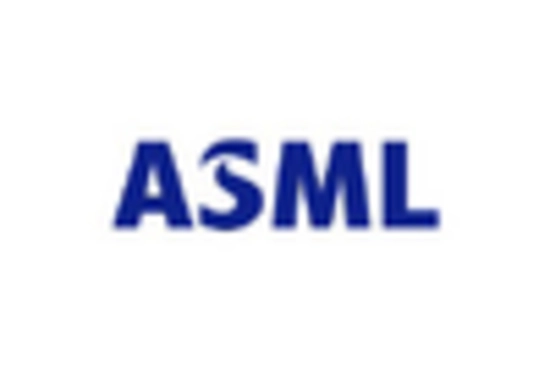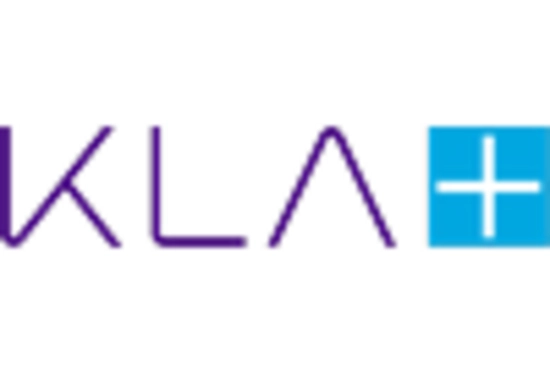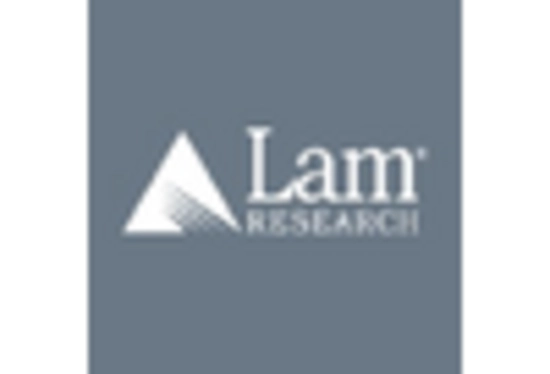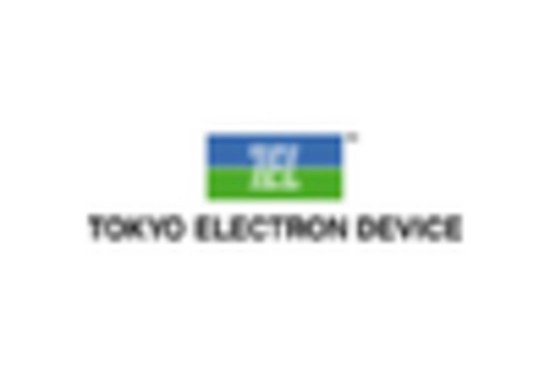-
EXECUTIVE SUMMARY
-
Market Overview
-
Key Findings
-
Market Segmentation
-
Competitive Landscape
-
Challenges and Opportunities
-
Future Outlook
-
\r\n
-
MARKET INTRODUCTION
-
Definition
-
Scope of the study
- Research Objective
- Assumption
- Limitations
-
RESEARCH METHODOLOGY
-
Overview
-
Data Mining
-
Secondary Research
-
Primary Research
- Primary Interviews and Information Gathering Process
- Breakdown of Primary Respondents
-
Forecasting Model
-
Market Size Estimation
- Bottom-Up Approach
- Top-Down Approach
-
Data Triangulation
-
Validation
-
\r\n
-
MARKET DYNAMICS
-
Overview
-
Drivers
-
Restraints
-
Opportunities
-
MARKET FACTOR ANALYSIS
-
Value chain Analysis
-
Porter's Five Forces Analysis
- Bargaining Power of Suppliers
- Bargaining Power of Buyers
- Threat of New Entrants
- Threat of Substitutes
- Intensity of Rivalry
-
COVID-19 Impact Analysis
- Market Impact Analysis
- Regional Impact
- Opportunity and Threat Analysis
-
\r\n
-
SEMICONDUCTOR PRODUCTION EQUIPMENT MARKET, BY EQUIPMENT TYPE (USD MILLION)
-
Front-End Equipment
-
Backend Equipment
-
Others
-
SEMICONDUCTOR PRODUCTION EQUIPMENT MARKET, BY PRODUCTS (USD MILLION)
-
Dicing Machine
-
Probing Machines
-
Sliced Wafer Demounting
-
Cleaning Machine
-
Wafer Edge Grinding Machine
-
Polish Grinders
-
Others
-
SEMICONDUCTOR PRODUCTION EQUIPMENT MARKET, BY DIMENSION (USD MILLION)
-
2D
-
5D
-
3D
-
Others
-
SEMICONDUCTOR PRODUCTION EQUIPMENT MARKET, BY REGIONAL (USD MILLION)
-
North America
- US
- Canada
-
Europe
- Germany
- UK
- France
- Russia
- Italy
- Spain
- Rest of Europe
-
APAC
- China
- India
- Japan
- South Korea
- Malaysia
- Thailand
- Indonesia
- Rest of APAC
-
South America
- Brazil
- Mexico
- Argentina
- Rest of South America
-
MEA
- GCC Countries
- South Africa
- Rest of MEA
-
\r\n
-
COMPETITIVE LANDSCAPE
-
Overview
-
Competitive Analysis
-
Market share Analysis
-
Major Growth Strategy in the Semiconductor Production Equipment Market
-
Competitive Benchmarking
-
Leading Players in Terms of Number of Developments in the Semiconductor Production Equipment Market
-
Key developments and growth strategies
- New Product Launch/Service Deployment
- Merger & Acquisitions
- Joint Ventures
-
Major Players Financial Matrix
- Sales and Operating Income
- Major Players R&D Expenditure. 2023
-
COMPANY PROFILES
-
Tokyo Electron
- Financial Overview
- Products Offered
- Key Developments
- SWOT Analysis
- Key Strategies
-
Nikon
- Financial Overview
- Products Offered
- Key Developments
- SWOT Analysis
- Key Strategies
-
SCREEN Semiconductor Solutions
- Financial Overview
- Products Offered
- Key Developments
- SWOT Analysis
- Key Strategies
-
Silicon Designs
- Financial Overview
- Products Offered
- Key Developments
- SWOT Analysis
- Key Strategies
-
Veeco Instruments
- Financial Overview
- Products Offered
- Key Developments
- SWOT Analysis
- Key Strategies
-
ASML
- Financial Overview
- Products Offered
- Key Developments
- SWOT Analysis
- Key Strategies
-
GX Technology
- Financial Overview
- Products Offered
- Key Developments
- SWOT Analysis
- Key Strategies
-
Chroma ATE
- Financial Overview
- Products Offered
- Key Developments
- SWOT Analysis
- Key Strategies
-
Hitachi HighTechnologies
- Financial Overview
- Products Offered
- Key Developments
- SWOT Analysis
- Key Strategies
-
Lam Research
- Financial Overview
- Products Offered
- Key Developments
- SWOT Analysis
- Key Strategies
-
Advantest
- Financial Overview
- Products Offered
- Key Developments
- SWOT Analysis
- Key Strategies
-
Teradyne
- Financial Overview
- Products Offered
- Key Developments
- SWOT Analysis
- Key Strategies
-
FormFactor
- Financial Overview
- Products Offered
- Key Developments
- SWOT Analysis
- Key Strategies
-
KLA
- Financial Overview
- Products Offered
- Key Developments
- SWOT Analysis
- Key Strategies
-
Applied Materials
- Financial Overview
- Products Offered
- Key Developments
- SWOT Analysis
- Key Strategies
-
APPENDIX
-
References
-
Related Reports
-
LIST OF TABLES
-
\r\n
-
LIST OF ASSUMPTIONS
-
NORTH AMERICA SEMICONDUCTOR PRODUCTION EQUIPMENT MARKET SIZE ESTIMATES & FORECAST, BY EQUIPMENT TYPE, 2019-2035 (USD BILLIONS)
-
NORTH AMERICA SEMICONDUCTOR PRODUCTION EQUIPMENT MARKET SIZE ESTIMATES & FORECAST, BY PRODUCTS, 2019-2035 (USD BILLIONS)
-
NORTH AMERICA SEMICONDUCTOR PRODUCTION EQUIPMENT MARKET SIZE ESTIMATES & FORECAST, BY DIMENSION, 2019-2035 (USD BILLIONS)
-
NORTH AMERICA SEMICONDUCTOR PRODUCTION EQUIPMENT MARKET SIZE ESTIMATES & FORECAST, BY REGIONAL, 2019-2035 (USD BILLIONS)
-
US SEMICONDUCTOR PRODUCTION EQUIPMENT MARKET SIZE ESTIMATES & FORECAST, BY EQUIPMENT TYPE, 2019-2035 (USD BILLIONS)
-
US SEMICONDUCTOR PRODUCTION EQUIPMENT MARKET SIZE ESTIMATES & FORECAST, BY PRODUCTS, 2019-2035 (USD BILLIONS)
-
US SEMICONDUCTOR PRODUCTION EQUIPMENT MARKET SIZE ESTIMATES & FORECAST, BY DIMENSION, 2019-2035 (USD BILLIONS)
-
US SEMICONDUCTOR PRODUCTION EQUIPMENT MARKET SIZE ESTIMATES & FORECAST, BY REGIONAL, 2019-2035 (USD BILLIONS)
-
CANADA SEMICONDUCTOR PRODUCTION EQUIPMENT MARKET SIZE ESTIMATES & FORECAST, BY EQUIPMENT TYPE, 2019-2035 (USD BILLIONS)
-
CANADA SEMICONDUCTOR PRODUCTION EQUIPMENT MARKET SIZE ESTIMATES & FORECAST, BY PRODUCTS, 2019-2035 (USD BILLIONS)
-
CANADA SEMICONDUCTOR PRODUCTION EQUIPMENT MARKET SIZE ESTIMATES & FORECAST, BY DIMENSION, 2019-2035 (USD BILLIONS)
-
CANADA SEMICONDUCTOR PRODUCTION EQUIPMENT MARKET SIZE ESTIMATES & FORECAST, BY REGIONAL, 2019-2035 (USD BILLIONS)
-
EUROPE SEMICONDUCTOR PRODUCTION EQUIPMENT MARKET SIZE ESTIMATES & FORECAST, BY EQUIPMENT TYPE, 2019-2035 (USD BILLIONS)
-
EUROPE SEMICONDUCTOR PRODUCTION EQUIPMENT MARKET SIZE ESTIMATES & FORECAST, BY PRODUCTS, 2019-2035 (USD BILLIONS)
-
EUROPE SEMICONDUCTOR PRODUCTION EQUIPMENT MARKET SIZE ESTIMATES & FORECAST, BY DIMENSION, 2019-2035 (USD BILLIONS)
-
EUROPE SEMICONDUCTOR PRODUCTION EQUIPMENT MARKET SIZE ESTIMATES & FORECAST, BY REGIONAL, 2019-2035 (USD BILLIONS)
-
GERMANY SEMICONDUCTOR PRODUCTION EQUIPMENT MARKET SIZE ESTIMATES & FORECAST, BY EQUIPMENT TYPE, 2019-2035 (USD BILLIONS)
-
GERMANY SEMICONDUCTOR PRODUCTION EQUIPMENT MARKET SIZE ESTIMATES & FORECAST, BY PRODUCTS, 2019-2035 (USD BILLIONS)
-
GERMANY SEMICONDUCTOR PRODUCTION EQUIPMENT MARKET SIZE ESTIMATES & FORECAST, BY DIMENSION, 2019-2035 (USD BILLIONS)
-
GERMANY SEMICONDUCTOR PRODUCTION EQUIPMENT MARKET SIZE ESTIMATES & FORECAST, BY REGIONAL, 2019-2035 (USD BILLIONS)
-
UK SEMICONDUCTOR PRODUCTION EQUIPMENT MARKET SIZE ESTIMATES & FORECAST, BY EQUIPMENT TYPE, 2019-2035 (USD BILLIONS)
-
UK SEMICONDUCTOR PRODUCTION EQUIPMENT MARKET SIZE ESTIMATES & FORECAST, BY PRODUCTS, 2019-2035 (USD BILLIONS)
-
UK SEMICONDUCTOR PRODUCTION EQUIPMENT MARKET SIZE ESTIMATES & FORECAST, BY DIMENSION, 2019-2035 (USD BILLIONS)
-
UK SEMICONDUCTOR PRODUCTION EQUIPMENT MARKET SIZE ESTIMATES & FORECAST, BY REGIONAL, 2019-2035 (USD BILLIONS)
-
FRANCE SEMICONDUCTOR PRODUCTION EQUIPMENT MARKET SIZE ESTIMATES & FORECAST, BY EQUIPMENT TYPE, 2019-2035 (USD BILLIONS)
-
FRANCE SEMICONDUCTOR PRODUCTION EQUIPMENT MARKET SIZE ESTIMATES & FORECAST, BY PRODUCTS, 2019-2035 (USD BILLIONS)
-
FRANCE SEMICONDUCTOR PRODUCTION EQUIPMENT MARKET SIZE ESTIMATES & FORECAST, BY DIMENSION, 2019-2035 (USD BILLIONS)
-
FRANCE SEMICONDUCTOR PRODUCTION EQUIPMENT MARKET SIZE ESTIMATES & FORECAST, BY REGIONAL, 2019-2035 (USD BILLIONS)
-
RUSSIA SEMICONDUCTOR PRODUCTION EQUIPMENT MARKET SIZE ESTIMATES & FORECAST, BY EQUIPMENT TYPE, 2019-2035 (USD BILLIONS)
-
RUSSIA SEMICONDUCTOR PRODUCTION EQUIPMENT MARKET SIZE ESTIMATES & FORECAST, BY PRODUCTS, 2019-2035 (USD BILLIONS)
-
RUSSIA SEMICONDUCTOR PRODUCTION EQUIPMENT MARKET SIZE ESTIMATES & FORECAST, BY DIMENSION, 2019-2035 (USD BILLIONS)
-
RUSSIA SEMICONDUCTOR PRODUCTION EQUIPMENT MARKET SIZE ESTIMATES & FORECAST, BY REGIONAL, 2019-2035 (USD BILLIONS)
-
ITALY SEMICONDUCTOR PRODUCTION EQUIPMENT MARKET SIZE ESTIMATES & FORECAST, BY EQUIPMENT TYPE, 2019-2035 (USD BILLIONS)
-
ITALY SEMICONDUCTOR PRODUCTION EQUIPMENT MARKET SIZE ESTIMATES & FORECAST, BY PRODUCTS, 2019-2035 (USD BILLIONS)
-
ITALY SEMICONDUCTOR PRODUCTION EQUIPMENT MARKET SIZE ESTIMATES & FORECAST, BY DIMENSION, 2019-2035 (USD BILLIONS)
-
ITALY SEMICONDUCTOR PRODUCTION EQUIPMENT MARKET SIZE ESTIMATES & FORECAST, BY REGIONAL, 2019-2035 (USD BILLIONS)
-
SPAIN SEMICONDUCTOR PRODUCTION EQUIPMENT MARKET SIZE ESTIMATES & FORECAST, BY EQUIPMENT TYPE, 2019-2035 (USD BILLIONS)
-
SPAIN SEMICONDUCTOR PRODUCTION EQUIPMENT MARKET SIZE ESTIMATES & FORECAST, BY PRODUCTS, 2019-2035 (USD BILLIONS)
-
SPAIN SEMICONDUCTOR PRODUCTION EQUIPMENT MARKET SIZE ESTIMATES & FORECAST, BY DIMENSION, 2019-2035 (USD BILLIONS)
-
SPAIN SEMICONDUCTOR PRODUCTION EQUIPMENT MARKET SIZE ESTIMATES & FORECAST, BY REGIONAL, 2019-2035 (USD BILLIONS)
-
REST OF EUROPE SEMICONDUCTOR PRODUCTION EQUIPMENT MARKET SIZE ESTIMATES & FORECAST, BY EQUIPMENT TYPE, 2019-2035 (USD BILLIONS)
-
REST OF EUROPE SEMICONDUCTOR PRODUCTION EQUIPMENT MARKET SIZE ESTIMATES & FORECAST, BY PRODUCTS, 2019-2035 (USD BILLIONS)
-
REST OF EUROPE SEMICONDUCTOR PRODUCTION EQUIPMENT MARKET SIZE ESTIMATES & FORECAST, BY DIMENSION, 2019-2035 (USD BILLIONS)
-
REST OF EUROPE SEMICONDUCTOR PRODUCTION EQUIPMENT MARKET SIZE ESTIMATES & FORECAST, BY REGIONAL, 2019-2035 (USD BILLIONS)
-
APAC SEMICONDUCTOR PRODUCTION EQUIPMENT MARKET SIZE ESTIMATES & FORECAST, BY EQUIPMENT TYPE, 2019-2035 (USD BILLIONS)
-
APAC SEMICONDUCTOR PRODUCTION EQUIPMENT MARKET SIZE ESTIMATES & FORECAST, BY PRODUCTS, 2019-2035 (USD BILLIONS)
-
APAC SEMICONDUCTOR PRODUCTION EQUIPMENT MARKET SIZE ESTIMATES & FORECAST, BY DIMENSION, 2019-2035 (USD BILLIONS)
-
APAC SEMICONDUCTOR PRODUCTION EQUIPMENT MARKET SIZE ESTIMATES & FORECAST, BY REGIONAL, 2019-2035 (USD BILLIONS)
-
CHINA SEMICONDUCTOR PRODUCTION EQUIPMENT MARKET SIZE ESTIMATES & FORECAST, BY EQUIPMENT TYPE, 2019-2035 (USD BILLIONS)
-
CHINA SEMICONDUCTOR PRODUCTION EQUIPMENT MARKET SIZE ESTIMATES & FORECAST, BY PRODUCTS, 2019-2035 (USD BILLIONS)
-
CHINA SEMICONDUCTOR PRODUCTION EQUIPMENT MARKET SIZE ESTIMATES & FORECAST, BY DIMENSION, 2019-2035 (USD BILLIONS)
-
CHINA SEMICONDUCTOR PRODUCTION EQUIPMENT MARKET SIZE ESTIMATES & FORECAST, BY REGIONAL, 2019-2035 (USD BILLIONS)
-
INDIA SEMICONDUCTOR PRODUCTION EQUIPMENT MARKET SIZE ESTIMATES & FORECAST, BY EQUIPMENT TYPE, 2019-2035 (USD BILLIONS)
-
INDIA SEMICONDUCTOR PRODUCTION EQUIPMENT MARKET SIZE ESTIMATES & FORECAST, BY PRODUCTS, 2019-2035 (USD BILLIONS)
-
INDIA SEMICONDUCTOR PRODUCTION EQUIPMENT MARKET SIZE ESTIMATES & FORECAST, BY DIMENSION, 2019-2035 (USD BILLIONS)
-
INDIA SEMICONDUCTOR PRODUCTION EQUIPMENT MARKET SIZE ESTIMATES & FORECAST, BY REGIONAL, 2019-2035 (USD BILLIONS)
-
JAPAN SEMICONDUCTOR PRODUCTION EQUIPMENT MARKET SIZE ESTIMATES & FORECAST, BY EQUIPMENT TYPE, 2019-2035 (USD BILLIONS)
-
JAPAN SEMICONDUCTOR PRODUCTION EQUIPMENT MARKET SIZE ESTIMATES & FORECAST, BY PRODUCTS, 2019-2035 (USD BILLIONS)
-
JAPAN SEMICONDUCTOR PRODUCTION EQUIPMENT MARKET SIZE ESTIMATES & FORECAST, BY DIMENSION, 2019-2035 (USD BILLIONS)
-
JAPAN SEMICONDUCTOR PRODUCTION EQUIPMENT MARKET SIZE ESTIMATES & FORECAST, BY REGIONAL, 2019-2035 (USD BILLIONS)
-
SOUTH KOREA SEMICONDUCTOR PRODUCTION EQUIPMENT MARKET SIZE ESTIMATES & FORECAST, BY EQUIPMENT TYPE, 2019-2035 (USD BILLIONS)
-
SOUTH KOREA SEMICONDUCTOR PRODUCTION EQUIPMENT MARKET SIZE ESTIMATES & FORECAST, BY PRODUCTS, 2019-2035 (USD BILLIONS)
-
SOUTH KOREA SEMICONDUCTOR PRODUCTION EQUIPMENT MARKET SIZE ESTIMATES & FORECAST, BY DIMENSION, 2019-2035 (USD BILLIONS)
-
SOUTH KOREA SEMICONDUCTOR PRODUCTION EQUIPMENT MARKET SIZE ESTIMATES & FORECAST, BY REGIONAL, 2019-2035 (USD BILLIONS)
-
MALAYSIA SEMICONDUCTOR PRODUCTION EQUIPMENT MARKET SIZE ESTIMATES & FORECAST, BY EQUIPMENT TYPE, 2019-2035 (USD BILLIONS)
-
MALAYSIA SEMICONDUCTOR PRODUCTION EQUIPMENT MARKET SIZE ESTIMATES & FORECAST, BY PRODUCTS, 2019-2035 (USD BILLIONS)
-
MALAYSIA SEMICONDUCTOR PRODUCTION EQUIPMENT MARKET SIZE ESTIMATES & FORECAST, BY DIMENSION, 2019-2035 (USD BILLIONS)
-
MALAYSIA SEMICONDUCTOR PRODUCTION EQUIPMENT MARKET SIZE ESTIMATES & FORECAST, BY REGIONAL, 2019-2035 (USD BILLIONS)
-
THAILAND SEMICONDUCTOR PRODUCTION EQUIPMENT MARKET SIZE ESTIMATES & FORECAST, BY EQUIPMENT TYPE, 2019-2035 (USD BILLIONS)
-
THAILAND SEMICONDUCTOR PRODUCTION EQUIPMENT MARKET SIZE ESTIMATES & FORECAST, BY PRODUCTS, 2019-2035 (USD BILLIONS)
-
THAILAND SEMICONDUCTOR PRODUCTION EQUIPMENT MARKET SIZE ESTIMATES & FORECAST, BY DIMENSION, 2019-2035 (USD BILLIONS)
-
THAILAND SEMICONDUCTOR PRODUCTION EQUIPMENT MARKET SIZE ESTIMATES & FORECAST, BY REGIONAL, 2019-2035 (USD BILLIONS)
-
INDONESIA SEMICONDUCTOR PRODUCTION EQUIPMENT MARKET SIZE ESTIMATES & FORECAST, BY EQUIPMENT TYPE, 2019-2035 (USD BILLIONS)
-
INDONESIA SEMICONDUCTOR PRODUCTION EQUIPMENT MARKET SIZE ESTIMATES & FORECAST, BY PRODUCTS, 2019-2035 (USD BILLIONS)
-
INDONESIA SEMICONDUCTOR PRODUCTION EQUIPMENT MARKET SIZE ESTIMATES & FORECAST, BY DIMENSION, 2019-2035 (USD BILLIONS)
-
INDONESIA SEMICONDUCTOR PRODUCTION EQUIPMENT MARKET SIZE ESTIMATES & FORECAST, BY REGIONAL, 2019-2035 (USD BILLIONS)
-
REST OF APAC SEMICONDUCTOR PRODUCTION EQUIPMENT MARKET SIZE ESTIMATES & FORECAST, BY EQUIPMENT TYPE, 2019-2035 (USD BILLIONS)
-
REST OF APAC SEMICONDUCTOR PRODUCTION EQUIPMENT MARKET SIZE ESTIMATES & FORECAST, BY PRODUCTS, 2019-2035 (USD BILLIONS)
-
REST OF APAC SEMICONDUCTOR PRODUCTION EQUIPMENT MARKET SIZE ESTIMATES & FORECAST, BY DIMENSION, 2019-2035 (USD BILLIONS)
-
REST OF APAC SEMICONDUCTOR PRODUCTION EQUIPMENT MARKET SIZE ESTIMATES & FORECAST, BY REGIONAL, 2019-2035 (USD BILLIONS)
-
SOUTH AMERICA SEMICONDUCTOR PRODUCTION EQUIPMENT MARKET SIZE ESTIMATES & FORECAST, BY EQUIPMENT TYPE, 2019-2035 (USD BILLIONS)
-
SOUTH AMERICA SEMICONDUCTOR PRODUCTION EQUIPMENT MARKET SIZE ESTIMATES & FORECAST, BY PRODUCTS, 2019-2035 (USD BILLIONS)
-
SOUTH AMERICA SEMICONDUCTOR PRODUCTION EQUIPMENT MARKET SIZE ESTIMATES & FORECAST, BY DIMENSION, 2019-2035 (USD BILLIONS)
-
SOUTH AMERICA SEMICONDUCTOR PRODUCTION EQUIPMENT MARKET SIZE ESTIMATES & FORECAST, BY REGIONAL, 2019-2035 (USD BILLIONS)
-
BRAZIL SEMICONDUCTOR PRODUCTION EQUIPMENT MARKET SIZE ESTIMATES & FORECAST, BY EQUIPMENT TYPE, 2019-2035 (USD BILLIONS)
-
BRAZIL SEMICONDUCTOR PRODUCTION EQUIPMENT MARKET SIZE ESTIMATES & FORECAST, BY PRODUCTS, 2019-2035 (USD BILLIONS)
-
BRAZIL SEMICONDUCTOR PRODUCTION EQUIPMENT MARKET SIZE ESTIMATES & FORECAST, BY DIMENSION, 2019-2035 (USD BILLIONS)
-
BRAZIL SEMICONDUCTOR PRODUCTION EQUIPMENT MARKET SIZE ESTIMATES & FORECAST, BY REGIONAL, 2019-2035 (USD BILLIONS)
-
MEXICO SEMICONDUCTOR PRODUCTION EQUIPMENT MARKET SIZE ESTIMATES & FORECAST, BY EQUIPMENT TYPE, 2019-2035 (USD BILLIONS)
-
MEXICO SEMICONDUCTOR PRODUCTION EQUIPMENT MARKET SIZE ESTIMATES & FORECAST, BY PRODUCTS, 2019-2035 (USD BILLIONS)
-
MEXICO SEMICONDUCTOR PRODUCTION EQUIPMENT MARKET SIZE ESTIMATES & FORECAST, BY DIMENSION, 2019-2035 (USD BILLIONS)
-
MEXICO SEMICONDUCTOR PRODUCTION EQUIPMENT MARKET SIZE ESTIMATES & FORECAST, BY REGIONAL, 2019-2035 (USD BILLIONS)
-
ARGENTINA SEMICONDUCTOR PRODUCTION EQUIPMENT MARKET SIZE ESTIMATES & FORECAST, BY EQUIPMENT TYPE, 2019-2035 (USD BILLIONS)
-
ARGENTINA SEMICONDUCTOR PRODUCTION EQUIPMENT MARKET SIZE ESTIMATES & FORECAST, BY PRODUCTS, 2019-2035 (USD BILLIONS)
-
ARGENTINA SEMICONDUCTOR PRODUCTION EQUIPMENT MARKET SIZE ESTIMATES & FORECAST, BY DIMENSION, 2019-2035 (USD BILLIONS)
-
ARGENTINA SEMICONDUCTOR PRODUCTION EQUIPMENT MARKET SIZE ESTIMATES & FORECAST, BY REGIONAL, 2019-2035 (USD BILLIONS)
-
REST OF SOUTH AMERICA SEMICONDUCTOR PRODUCTION EQUIPMENT MARKET SIZE ESTIMATES & FORECAST, BY EQUIPMENT TYPE, 2019-2035 (USD BILLIONS)
-
REST OF SOUTH AMERICA SEMICONDUCTOR PRODUCTION EQUIPMENT MARKET SIZE ESTIMATES & FORECAST, BY PRODUCTS, 2019-2035 (USD BILLIONS)
-
REST OF SOUTH AMERICA SEMICONDUCTOR PRODUCTION EQUIPMENT MARKET SIZE ESTIMATES & FORECAST, BY DIMENSION, 2019-2035 (USD BILLIONS)
-
REST OF SOUTH AMERICA SEMICONDUCTOR PRODUCTION EQUIPMENT MARKET SIZE ESTIMATES & FORECAST, BY REGIONAL, 2019-2035 (USD BILLIONS)
-
MEA SEMICONDUCTOR PRODUCTION EQUIPMENT MARKET SIZE ESTIMATES & FORECAST, BY EQUIPMENT TYPE, 2019-2035 (USD BILLIONS)
-
MEA SEMICONDUCTOR PRODUCTION EQUIPMENT MARKET SIZE ESTIMATES & FORECAST, BY PRODUCTS, 2019-2035 (USD BILLIONS)
-
MEA SEMICONDUCTOR PRODUCTION EQUIPMENT MARKET SIZE ESTIMATES & FORECAST, BY DIMENSION, 2019-2035 (USD BILLIONS)
-
MEA SEMICONDUCTOR PRODUCTION EQUIPMENT MARKET SIZE ESTIMATES & FORECAST, BY REGIONAL, 2019-2035 (USD BILLIONS)
-
GCC COUNTRIES SEMICONDUCTOR PRODUCTION EQUIPMENT MARKET SIZE ESTIMATES & FORECAST, BY EQUIPMENT TYPE, 2019-2035 (USD BILLIONS)
-
GCC COUNTRIES SEMICONDUCTOR PRODUCTION EQUIPMENT MARKET SIZE ESTIMATES & FORECAST, BY PRODUCTS, 2019-2035 (USD BILLIONS)
-
GCC COUNTRIES SEMICONDUCTOR PRODUCTION EQUIPMENT MARKET SIZE ESTIMATES & FORECAST, BY DIMENSION, 2019-2035 (USD BILLIONS)
-
GCC COUNTRIES SEMICONDUCTOR PRODUCTION EQUIPMENT MARKET SIZE ESTIMATES & FORECAST, BY REGIONAL, 2019-2035 (USD BILLIONS)
-
SOUTH AFRICA SEMICONDUCTOR PRODUCTION EQUIPMENT MARKET SIZE ESTIMATES & FORECAST, BY EQUIPMENT TYPE, 2019-2035 (USD BILLIONS)
-
SOUTH AFRICA SEMICONDUCTOR PRODUCTION EQUIPMENT MARKET SIZE ESTIMATES & FORECAST, BY PRODUCTS, 2019-2035 (USD BILLIONS)
-
SOUTH AFRICA SEMICONDUCTOR PRODUCTION EQUIPMENT MARKET SIZE ESTIMATES & FORECAST, BY DIMENSION, 2019-2035 (USD BILLIONS)
-
SOUTH AFRICA SEMICONDUCTOR PRODUCTION EQUIPMENT MARKET SIZE ESTIMATES & FORECAST, BY REGIONAL, 2019-2035 (USD BILLIONS)
-
REST OF MEA SEMICONDUCTOR PRODUCTION EQUIPMENT MARKET SIZE ESTIMATES & FORECAST, BY EQUIPMENT TYPE, 2019-2035 (USD BILLIONS)
-
REST OF MEA SEMICONDUCTOR PRODUCTION EQUIPMENT MARKET SIZE ESTIMATES & FORECAST, BY PRODUCTS, 2019-2035 (USD BILLIONS)
-
REST OF MEA SEMICONDUCTOR PRODUCTION EQUIPMENT MARKET SIZE ESTIMATES & FORECAST, BY DIMENSION, 2019-2035 (USD BILLIONS)
-
REST OF MEA SEMICONDUCTOR PRODUCTION EQUIPMENT MARKET SIZE ESTIMATES & FORECAST, BY REGIONAL, 2019-2035 (USD BILLIONS)
-
PRODUCT LAUNCH/PRODUCT DEVELOPMENT/APPROVAL
-
ACQUISITION/PARTNERSHIP
-
\r\n
-
\r\n
-
\r\n
-
\r\n
-
\r\n
-
\r\n
-
\r\n
-
\r\n
-
\r\n
-
\r\n
-
\r\n
-
\r\n
-
\r\n
-
\r\n
-
\r\n
-
LIST OF FIGURES
-
\r\n
-
MARKET SYNOPSIS
-
NORTH AMERICA SEMICONDUCTOR PRODUCTION EQUIPMENT MARKET ANALYSIS
-
US SEMICONDUCTOR PRODUCTION EQUIPMENT MARKET ANALYSIS BY EQUIPMENT TYPE
-
US SEMICONDUCTOR PRODUCTION EQUIPMENT MARKET ANALYSIS BY PRODUCTS
-
US SEMICONDUCTOR PRODUCTION EQUIPMENT MARKET ANALYSIS BY DIMENSION
-
US SEMICONDUCTOR PRODUCTION EQUIPMENT MARKET ANALYSIS BY REGIONAL
-
CANADA SEMICONDUCTOR PRODUCTION EQUIPMENT MARKET ANALYSIS BY EQUIPMENT TYPE
-
CANADA SEMICONDUCTOR PRODUCTION EQUIPMENT MARKET ANALYSIS BY PRODUCTS
-
CANADA SEMICONDUCTOR PRODUCTION EQUIPMENT MARKET ANALYSIS BY DIMENSION
-
CANADA SEMICONDUCTOR PRODUCTION EQUIPMENT MARKET ANALYSIS BY REGIONAL
-
EUROPE SEMICONDUCTOR PRODUCTION EQUIPMENT MARKET ANALYSIS
-
GERMANY SEMICONDUCTOR PRODUCTION EQUIPMENT MARKET ANALYSIS BY EQUIPMENT TYPE
-
GERMANY SEMICONDUCTOR PRODUCTION EQUIPMENT MARKET ANALYSIS BY PRODUCTS
-
GERMANY SEMICONDUCTOR PRODUCTION EQUIPMENT MARKET ANALYSIS BY DIMENSION
-
GERMANY SEMICONDUCTOR PRODUCTION EQUIPMENT MARKET ANALYSIS BY REGIONAL
-
UK SEMICONDUCTOR PRODUCTION EQUIPMENT MARKET ANALYSIS BY EQUIPMENT TYPE
-
UK SEMICONDUCTOR PRODUCTION EQUIPMENT MARKET ANALYSIS BY PRODUCTS
-
UK SEMICONDUCTOR PRODUCTION EQUIPMENT MARKET ANALYSIS BY DIMENSION
-
UK SEMICONDUCTOR PRODUCTION EQUIPMENT MARKET ANALYSIS BY REGIONAL
-
FRANCE SEMICONDUCTOR PRODUCTION EQUIPMENT MARKET ANALYSIS BY EQUIPMENT TYPE
-
FRANCE SEMICONDUCTOR PRODUCTION EQUIPMENT MARKET ANALYSIS BY PRODUCTS
-
FRANCE SEMICONDUCTOR PRODUCTION EQUIPMENT MARKET ANALYSIS BY DIMENSION
-
FRANCE SEMICONDUCTOR PRODUCTION EQUIPMENT MARKET ANALYSIS BY REGIONAL
-
RUSSIA SEMICONDUCTOR PRODUCTION EQUIPMENT MARKET ANALYSIS BY EQUIPMENT TYPE
-
RUSSIA SEMICONDUCTOR PRODUCTION EQUIPMENT MARKET ANALYSIS BY PRODUCTS
-
RUSSIA SEMICONDUCTOR PRODUCTION EQUIPMENT MARKET ANALYSIS BY DIMENSION
-
RUSSIA SEMICONDUCTOR PRODUCTION EQUIPMENT MARKET ANALYSIS BY REGIONAL
-
ITALY SEMICONDUCTOR PRODUCTION EQUIPMENT MARKET ANALYSIS BY EQUIPMENT TYPE
-
ITALY SEMICONDUCTOR PRODUCTION EQUIPMENT MARKET ANALYSIS BY PRODUCTS
-
ITALY SEMICONDUCTOR PRODUCTION EQUIPMENT MARKET ANALYSIS BY DIMENSION
-
ITALY SEMICONDUCTOR PRODUCTION EQUIPMENT MARKET ANALYSIS BY REGIONAL
-
SPAIN SEMICONDUCTOR PRODUCTION EQUIPMENT MARKET ANALYSIS BY EQUIPMENT TYPE
-
SPAIN SEMICONDUCTOR PRODUCTION EQUIPMENT MARKET ANALYSIS BY PRODUCTS
-
SPAIN SEMICONDUCTOR PRODUCTION EQUIPMENT MARKET ANALYSIS BY DIMENSION
-
SPAIN SEMICONDUCTOR PRODUCTION EQUIPMENT MARKET ANALYSIS BY REGIONAL
-
REST OF EUROPE SEMICONDUCTOR PRODUCTION EQUIPMENT MARKET ANALYSIS BY EQUIPMENT TYPE
-
REST OF EUROPE SEMICONDUCTOR PRODUCTION EQUIPMENT MARKET ANALYSIS BY PRODUCTS
-
REST OF EUROPE SEMICONDUCTOR PRODUCTION EQUIPMENT MARKET ANALYSIS BY DIMENSION
-
REST OF EUROPE SEMICONDUCTOR PRODUCTION EQUIPMENT MARKET ANALYSIS BY REGIONAL
-
APAC SEMICONDUCTOR PRODUCTION EQUIPMENT MARKET ANALYSIS
-
CHINA SEMICONDUCTOR PRODUCTION EQUIPMENT MARKET ANALYSIS BY EQUIPMENT TYPE
-
CHINA SEMICONDUCTOR PRODUCTION EQUIPMENT MARKET ANALYSIS BY PRODUCTS
-
CHINA SEMICONDUCTOR PRODUCTION EQUIPMENT MARKET ANALYSIS BY DIMENSION
-
CHINA SEMICONDUCTOR PRODUCTION EQUIPMENT MARKET ANALYSIS BY REGIONAL
-
INDIA SEMICONDUCTOR PRODUCTION EQUIPMENT MARKET ANALYSIS BY EQUIPMENT TYPE
-
INDIA SEMICONDUCTOR PRODUCTION EQUIPMENT MARKET ANALYSIS BY PRODUCTS
-
INDIA SEMICONDUCTOR PRODUCTION EQUIPMENT MARKET ANALYSIS BY DIMENSION
-
INDIA SEMICONDUCTOR PRODUCTION EQUIPMENT MARKET ANALYSIS BY REGIONAL
-
JAPAN SEMICONDUCTOR PRODUCTION EQUIPMENT MARKET ANALYSIS BY EQUIPMENT TYPE
-
JAPAN SEMICONDUCTOR PRODUCTION EQUIPMENT MARKET ANALYSIS BY PRODUCTS
-
JAPAN SEMICONDUCTOR PRODUCTION EQUIPMENT MARKET ANALYSIS BY DIMENSION
-
JAPAN SEMICONDUCTOR PRODUCTION EQUIPMENT MARKET ANALYSIS BY REGIONAL
-
SOUTH KOREA SEMICONDUCTOR PRODUCTION EQUIPMENT MARKET ANALYSIS BY EQUIPMENT TYPE
-
SOUTH KOREA SEMICONDUCTOR PRODUCTION EQUIPMENT MARKET ANALYSIS BY PRODUCTS
-
SOUTH KOREA SEMICONDUCTOR PRODUCTION EQUIPMENT MARKET ANALYSIS BY DIMENSION
-
SOUTH KOREA SEMICONDUCTOR PRODUCTION EQUIPMENT MARKET ANALYSIS BY REGIONAL
-
MALAYSIA SEMICONDUCTOR PRODUCTION EQUIPMENT MARKET ANALYSIS BY EQUIPMENT TYPE
-
MALAYSIA SEMICONDUCTOR PRODUCTION EQUIPMENT MARKET ANALYSIS BY PRODUCTS
-
MALAYSIA SEMICONDUCTOR PRODUCTION EQUIPMENT MARKET ANALYSIS BY DIMENSION
-
MALAYSIA SEMICONDUCTOR PRODUCTION EQUIPMENT MARKET ANALYSIS BY REGIONAL
-
THAILAND SEMICONDUCTOR PRODUCTION EQUIPMENT MARKET ANALYSIS BY EQUIPMENT TYPE
-
THAILAND SEMICONDUCTOR PRODUCTION EQUIPMENT MARKET ANALYSIS BY PRODUCTS
-
THAILAND SEMICONDUCTOR PRODUCTION EQUIPMENT MARKET ANALYSIS BY DIMENSION
-
THAILAND SEMICONDUCTOR PRODUCTION EQUIPMENT MARKET ANALYSIS BY REGIONAL
-
INDONESIA SEMICONDUCTOR PRODUCTION EQUIPMENT MARKET ANALYSIS BY EQUIPMENT TYPE
-
INDONESIA SEMICONDUCTOR PRODUCTION EQUIPMENT MARKET ANALYSIS BY PRODUCTS
-
INDONESIA SEMICONDUCTOR PRODUCTION EQUIPMENT MARKET ANALYSIS BY DIMENSION
-
INDONESIA SEMICONDUCTOR PRODUCTION EQUIPMENT MARKET ANALYSIS BY REGIONAL
-
REST OF APAC SEMICONDUCTOR PRODUCTION EQUIPMENT MARKET ANALYSIS BY EQUIPMENT TYPE
-
REST OF APAC SEMICONDUCTOR PRODUCTION EQUIPMENT MARKET ANALYSIS BY PRODUCTS
-
REST OF APAC SEMICONDUCTOR PRODUCTION EQUIPMENT MARKET ANALYSIS BY DIMENSION
-
REST OF APAC SEMICONDUCTOR PRODUCTION EQUIPMENT MARKET ANALYSIS BY REGIONAL
-
SOUTH AMERICA SEMICONDUCTOR PRODUCTION EQUIPMENT MARKET ANALYSIS
-
BRAZIL SEMICONDUCTOR PRODUCTION EQUIPMENT MARKET ANALYSIS BY EQUIPMENT TYPE
-
BRAZIL SEMICONDUCTOR PRODUCTION EQUIPMENT MARKET ANALYSIS BY PRODUCTS
-
BRAZIL SEMICONDUCTOR PRODUCTION EQUIPMENT MARKET ANALYSIS BY DIMENSION
-
BRAZIL SEMICONDUCTOR PRODUCTION EQUIPMENT MARKET ANALYSIS BY REGIONAL
-
MEXICO SEMICONDUCTOR PRODUCTION EQUIPMENT MARKET ANALYSIS BY EQUIPMENT TYPE
-
MEXICO SEMICONDUCTOR PRODUCTION EQUIPMENT MARKET ANALYSIS BY PRODUCTS
-
MEXICO SEMICONDUCTOR PRODUCTION EQUIPMENT MARKET ANALYSIS BY DIMENSION
-
MEXICO SEMICONDUCTOR PRODUCTION EQUIPMENT MARKET ANALYSIS BY REGIONAL
-
ARGENTINA SEMICONDUCTOR PRODUCTION EQUIPMENT MARKET ANALYSIS BY EQUIPMENT TYPE
-
ARGENTINA SEMICONDUCTOR PRODUCTION EQUIPMENT MARKET ANALYSIS BY PRODUCTS
-
ARGENTINA SEMICONDUCTOR PRODUCTION EQUIPMENT MARKET ANALYSIS BY DIMENSION
-
ARGENTINA SEMICONDUCTOR PRODUCTION EQUIPMENT MARKET ANALYSIS BY REGIONAL
-
REST OF SOUTH AMERICA SEMICONDUCTOR PRODUCTION EQUIPMENT MARKET ANALYSIS BY EQUIPMENT TYPE
-
REST OF SOUTH AMERICA SEMICONDUCTOR PRODUCTION EQUIPMENT MARKET ANALYSIS BY PRODUCTS
-
REST OF SOUTH AMERICA SEMICONDUCTOR PRODUCTION EQUIPMENT MARKET ANALYSIS BY DIMENSION
-
REST OF SOUTH AMERICA SEMICONDUCTOR PRODUCTION EQUIPMENT MARKET ANALYSIS BY REGIONAL
-
MEA SEMICONDUCTOR PRODUCTION EQUIPMENT MARKET ANALYSIS
-
GCC COUNTRIES SEMICONDUCTOR PRODUCTION EQUIPMENT MARKET ANALYSIS BY EQUIPMENT TYPE
-
GCC COUNTRIES SEMICONDUCTOR PRODUCTION EQUIPMENT MARKET ANALYSIS BY PRODUCTS
-
GCC COUNTRIES SEMICONDUCTOR PRODUCTION EQUIPMENT MARKET ANALYSIS BY DIMENSION
-
GCC COUNTRIES SEMICONDUCTOR PRODUCTION EQUIPMENT MARKET ANALYSIS BY REGIONAL
-
SOUTH AFRICA SEMICONDUCTOR PRODUCTION EQUIPMENT MARKET ANALYSIS BY EQUIPMENT TYPE
-
SOUTH AFRICA SEMICONDUCTOR PRODUCTION EQUIPMENT MARKET ANALYSIS BY PRODUCTS
-
SOUTH AFRICA SEMICONDUCTOR PRODUCTION EQUIPMENT MARKET ANALYSIS BY DIMENSION
-
SOUTH AFRICA SEMICONDUCTOR PRODUCTION EQUIPMENT MARKET ANALYSIS BY REGIONAL
-
REST OF MEA SEMICONDUCTOR PRODUCTION EQUIPMENT MARKET ANALYSIS BY EQUIPMENT TYPE
-
REST OF MEA SEMICONDUCTOR PRODUCTION EQUIPMENT MARKET ANALYSIS BY PRODUCTS
-
REST OF MEA SEMICONDUCTOR PRODUCTION EQUIPMENT MARKET ANALYSIS BY DIMENSION
-
REST OF MEA SEMICONDUCTOR PRODUCTION EQUIPMENT MARKET ANALYSIS BY REGIONAL
-
KEY BUYING CRITERIA OF SEMICONDUCTOR PRODUCTION EQUIPMENT MARKET
-
RESEARCH PROCESS OF MRFR
-
DRO ANALYSIS OF SEMICONDUCTOR PRODUCTION EQUIPMENT MARKET
-
DRIVERS IMPACT ANALYSIS: SEMICONDUCTOR PRODUCTION EQUIPMENT MARKET
-
RESTRAINTS IMPACT ANALYSIS: SEMICONDUCTOR PRODUCTION EQUIPMENT MARKET
-
SUPPLY / VALUE CHAIN: SEMICONDUCTOR PRODUCTION EQUIPMENT MARKET
-
SEMICONDUCTOR PRODUCTION EQUIPMENT MARKET, BY EQUIPMENT TYPE, 2025 (% SHARE)
-
SEMICONDUCTOR PRODUCTION EQUIPMENT MARKET, BY EQUIPMENT TYPE, 2019 TO 2035 (USD Billions)
-
SEMICONDUCTOR PRODUCTION EQUIPMENT MARKET, BY PRODUCTS, 2025 (% SHARE)
-
SEMICONDUCTOR PRODUCTION EQUIPMENT MARKET, BY PRODUCTS, 2019 TO 2035 (USD Billions)
-
SEMICONDUCTOR PRODUCTION EQUIPMENT MARKET, BY DIMENSION, 2025 (% SHARE)
-
SEMICONDUCTOR PRODUCTION EQUIPMENT MARKET, BY DIMENSION, 2019 TO 2035 (USD Billions)
-
SEMICONDUCTOR PRODUCTION EQUIPMENT MARKET, BY REGIONAL, 2025 (% SHARE)
-
SEMICONDUCTOR PRODUCTION EQUIPMENT MARKET, BY REGIONAL, 2019 TO 2035 (USD Billions)
-
BENCHMARKING OF MAJOR COMPETITORS
-
\r\n
-
"







Leave a Comment